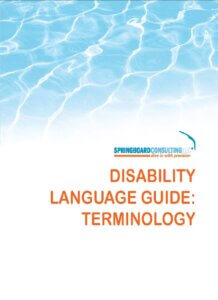DISABILITY LANGUAGE GUIDE: TERMINOLOGY
A self-directed on the most commonly used terms when referring to or communicating with someone with a disability.
 |
Disability Language Guide: TerminologyFormat: Electronic (PDF) Total Number of Pages: 37 Table of Contents: PDF Cost: $2,500 USD – Includes a royalty-free, paid-up, non-exclusive |
ABOUT THE GUIDE:
As language, perceptions, and what’s considered to be politically correct constantly changes.
It is often challenging to know how to refer to individuals with disabilities, especially so in the workplace.
This guide addresses the most commonly used terms when referring to or communicating with someone with a disability.
First, we would like to offer some basic guidelines:
- When possible, ask sources how they would like to be described.
- Avoid made-up words like “differently-abled” “diversability” and “handicapable.”
- Be sensitive when using words like “disorder,” “impairment,” “abnormality” and “special” to describe the nature of a disability as it can be taken as judgmental.
- There are exceptions such as when a doctor uses the term “Disorder” to refer to a medical condition or when the world “special” is used by a teacher to refer to special education.
- Always avoid using terms such as “suffers from” or “afflicted with” in association with any disability.
Keep in mind no two people with disabilities, even the same disability, are alike or feel similarly about their disability, or the language that is used to describe them. Having said that, when possible, it is always a good idea to ask the individual how they would like to be referenced in relation to their disability.